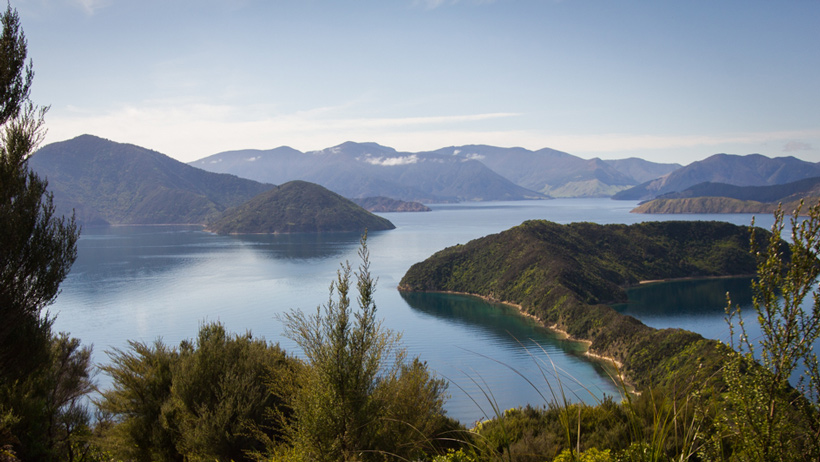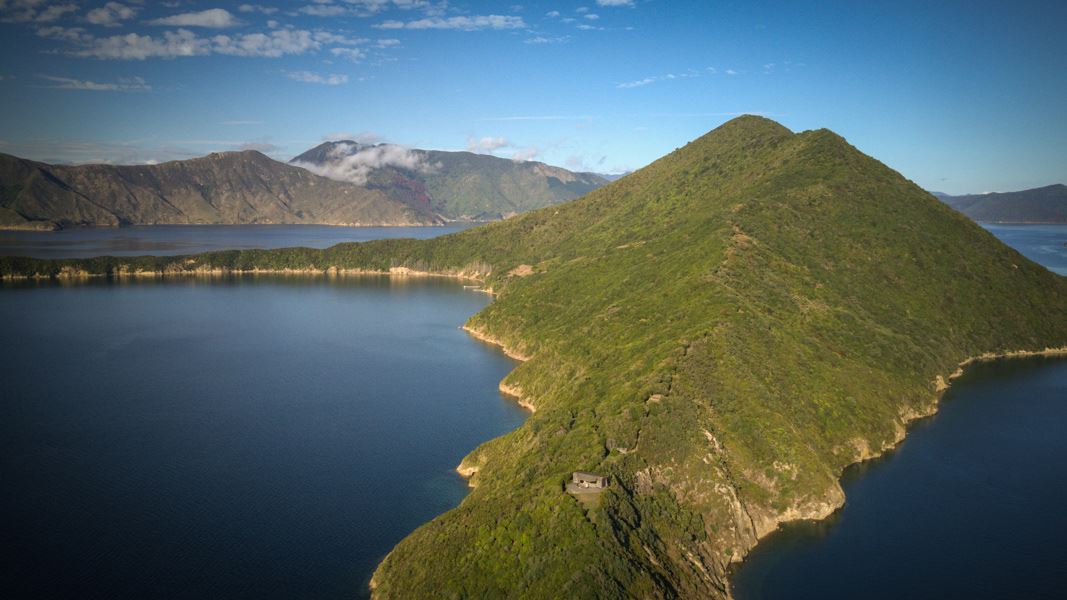You must have a permit to visit
The island is a closed scientific reserve. Entry permits are usually only granted for conservation research and DOC weed control programmes.
Private boats, kayaks, jet-skis, paddleboards, swimmers and any other form of private vessel must not land at Te Pākeka/Maud Island (Scientific Reserve).
Local schools visit the island annually by arrangement with island staff.
The general public have a chance to visit through specially-permitted commercial trips during January.
For information about visiting, contact the Picton DOC office picton@doc.govt.nz.
Te Pākeka/Maud Island has been historically free of rodents, possums, mustelids, and browsing animals. Its predator-free status makes it a haven for rare and unique wildlife.
Lizards
Te Pākeka is one of only four sites for the vulnerable Southern striped gecko (Toropuku stephensi), one of New Zealand’s rarest geckos.
The island also harbours very healthy populations of the Raukawa gecko (Woodworthia maculata), forest gecko, and glossy brown skink (Oligosoma zelandicum).
The speckled skink (Oligosoma infrapunctatum) has been introduced as part of restoring the island’s natural biodiversity.
Maud Island frog
Fossil records show that this once widespread species was found from Waikato to Punakaiki. However it is now confined to predator free islands after being wiped out by introduced rodents, stoats, and cats. Maud Island hosts the main population of this species, with approximately 60,000 estimated to live here (2016).
Invertebrates
The island is a stronghold for a number of rare invertebrate species now extinct or greatly restricted in range on the mainland.
These include a giant flesh-eating snail Powelliphanta hochstetteri obscura, the Cook Strait click beetle (Amychus granulatus) and the flax weevil (Anagotus fairburnii).
Tree wētā, ground wētā and over four species of cave wētā also inhabit the island.
The Cook Strait giant wētā (Deinicrida rugosa) was translocated to Maud from Mana Island in 1977. These gentle giants now reside on the island in healthy numbers.
Birds
The island hosts a number of forest birds including rifleman, kereru, tui, korimako/bellbird, piwakaka/fantails, kōtare/kingfisher, riorio/grey warbler, tahou/silvereye, kārearea/falcon, kahu/harrier, pipit, pūkeko, shining cuckoo, and ruru/morepork.
Marine environment
The shores and cliffs provide habitat for korora/little blue penguins, variable oystercatchers, reef herons, spotted, pied, shags, flesh footed shearwater, fluttering shearwater, Australasian gannets, and Caspian and white-fronted terns.
Bottle-nose and Dusky dolphins are regularly seen feeding and travelling around the island. Orca visit seasonally. New Zealand fur seals are also found around the coast.
There is a no-finned fish take zone around and beyond the whole island, administered by the Ministry for Primary Industries.
Vegetation
A 15-hectare remnant in Home Bay is a fine example of the original lush forest that covered all of the island before being razed for pasture. Its dominant trees include kohekohe, tawa, nikau, pukatea and mahoe. Large emergent podocarps were also once a significant element of the forest, especially matai, miro and rimu. These were largely lost when the island was cleared.

Vegetation on Maud Island
The remainder of the island is cloaked in young regenerating forest and scrub communities. There is a predominance of tauhinu, fiver-finger, mahoe, manuka, kaikomako, mamaku/tree fern and exotic species tree lucerne and Spanish heath.
The revegetation continues to expand in the absence of pests such as possums, rodents, goats, and deer.
Several species of plants uncommon in the Marlborough Sounds or rare on the mainland occur naturally on the Island. These include the large-leaved milk tree, hutu, ramarama, Sonchus kirkii and renga renga lily.
A nationally-threatened shrub from Titirangi (Hebe speciosa) was successfully introduced to Te Pākeka/Maud Island, establishing a second South Island population.
There is clear evidence of Maori occupation on Te Pākeka/Maud Island. The name Te Pākeka alludes to the extensive gardening that occurred on the island. Five sites of archaeological note are recorded, including probable garden areas and food storage pits.
In 1867 the Crown granted ownership of Te Pākeka/Maud Island to John Gibson, a farmer. A significant area of the island was cleared of forest for pasture.
During World War II, a network of military installations was constructed on the island. These included a gun emplacement and range finding equipment that are still there today. A jetty and roads were built at that time.
Maud Island first served as a wildlife refuge in 1974. The owner then, Jack Shand, agreed for the island be used as a home for what was believed (at the time) to be the last kākāpō from Fiordland. The move gave Maud the distinction of being the first safe haven for kākāpō.
Kākāpō remained a part of the island wildlife – with numbers reaching 18 at their peak in 2000 – until May 2003 when the last five were moved from Maud Island to more suitable islands.
Jack Shand gifted some of the island including its forest remnants to the Crown in 1971. He was later instrumental in ensuring the island's future as a sanctuary when he offered Maud for sale to the Crown.
At the time, the cash-strapped Wildlife Service could not afford to pay the $78,000 for the island. But the Royal Forest and Bird Protection Society secured its purchase by leading a public fundraising campaign.
It became the Tom Shand Nature Reserve, then later its status was altered to Scientific Reserve.
DOC Customer Service Centre
| Phone: | 0800 275 362 |
| Email: | picton@doc.govt.nz |
| Address: | Waitohi / Picton Office |
